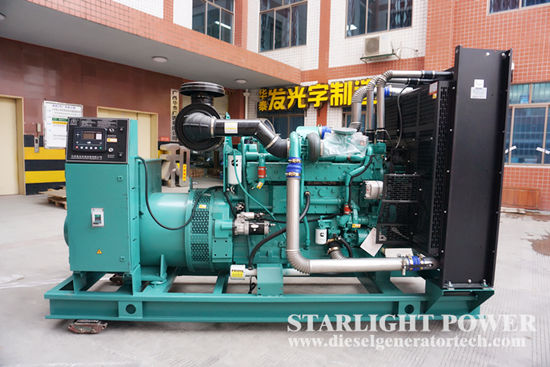During the operation of diesel generator set, the oil absorbs a certain amount of heat when it flows through the friction surface of moving parts. With the reciprocating cycle of the oil, the oil temperature will gradually increase. If the oil temperature exceeds the specified value, the viscosity of the oil will be seriously reduced and the lubricating effect will be lost. At the same time, the oil will be oxidized and deteriorated. Therefore, oil cooling device must be installed in the lubricating oil circuit of diesel engine.
1.The function of oil cooler
The function of the oil cooler is to cool the lubricating oil and keep the oil temperature in the most favorable temperature range (80 ~ 105 ℃). The lubricating oil absorbs a lot of heat when it works in the high temperature zone of diesel engine, at the same time, lubricating oil can cool the piston as cooling medium. Therefore, temperature of lubricating oil will increase, and the viscosity of lubricating oil decreases and it is easy to oxidize and deteriorate. Therefore, it is necessary to reduce the temperature of lubricating oil in time to ensure the normal operation of diesel engine.

2.According to structure of oil cooler: it can be divided into water-cooled cooler and air cooled cooler
A.Water cooled oil cooler.
Water cooled oil cooler is mainly composed of core and shell. The core is composed of brass tube, heat sink and spacer, and the oil flows between the interlayer of core and shell. However, when water flows inside the core, it takes away part of the heat from the oil. The temperature of the oil is controlled within 80℃±5℃ by reciprocating circulation of cooling water.
B.Air-cooled engine oil cooler.
Air cooled oil cooler is mainly composed of copper tube and heat sink. The oil cooler of air-cooled diesel engine is installed behind the water cooler, and the heat is taken away by the fan.
3.Engine oil cooler of Cummins diesel generator set
Oil cooler cover of Cummins B, C series diesel engine and the oil frega filter head are one casting connected together. The lubricating oil pressure regulating valve and frega filter bypass valve are both installed in the casting. The oil cooler is of plate warping type. The gaskets between chips and between chips and bottom plate are welded together. The oil cooler is built-in and installed in the water jacket of cylinder block, the heat sink is immersed in the water chamber of the cylinder block, and the high temperature lubricating oil flows into the oil cooler from the oil inlet hole. Each heat sink transmits heat to the coolant, thus reducing the temperature of the lubricating oil, so as to prevent the damage of various parts of the diesel engine due to the high temperature and poor lubrication of the lubricating oil.
In the actual operation, the lubricating oil pressure of the diesel engine changes with the working environment and conditions. The oil pressure regulating valve can reduce the lubricating oil pressure of the lubricating system when the diesel engine is cold started, and can adjust the lubricating oil pressure of the system when the lubricating oil temperature rises. The lubricating oil pressure regulating valve (pressure regulating valve and oil return valve) is composed of spring, plunger (steel ball) and valve seat. When the oil pressure is less than the opening pressure of the pressure regulating valve, the pressure regulating valve is closed. When the lubricating oil pressure is greater than the opening pressure of the pressure regulating valve, the pressure regulating valve opens and some lubricating oil directly returns to the oil pan. The higher the pressure is, the greater the opening of the valve is, so as to keep the lubricating oil pressure within the normal range.
Cummins C series diesel engine of generator set is equipped with an oil thermostat on the top of the oil cooler cover. When the lubricating oil temperature is between 100℃ and 115℃, the thermostat regulates the flow of lubricating oil through the oil cooler. If the oil temperature is low, the thermostat opens, allowing a portion of the oil to flow directly to the frega filter. When the temperature of the lubricating oil rises to 115 ℃, the thermostat allows all the lubricating oil to pass through the oil cooler.
When the temperature of the lubricating oil rises to 115℃, the thermostat allows all the lubricating oil to pass through the oil cooler. The thermostat is also equipped with a pressure regulating device, which acts as a bypass valve to bypass the cooler when the oil cooler is blocked. Installation position of pressure regulating valve and thermostat of oil cooler of Cummins C series diesel engine. It is built in the oil chamber of the diesel engine, and it is not easy to be damaged by the diesel engine. However, N series diesel engine oil cooler adopts tube bundle type, which is located at the side of diesel engine exhaust pipe, and consists of cooler core, shell, front cover, rear cover, O-ring, etc.
Engine oil cooler is also an important part of diesel generator set. Hope you can learn something from above information. Starlight Power has focused on producing and selling high quality diesel generator set for more than 45 years, having its own factory. If you have plan to purchase electric generator, please contact us by email sales@dieselgeneratortech.com.
Comments
Post a Comment